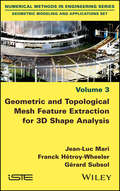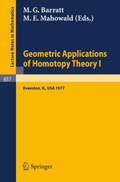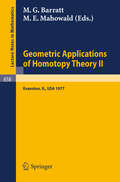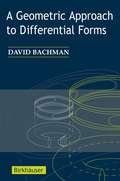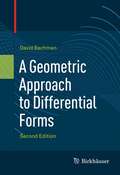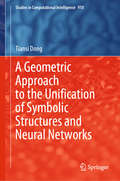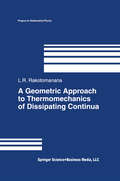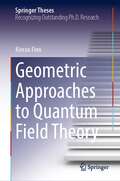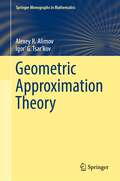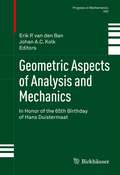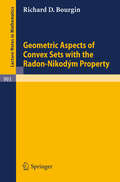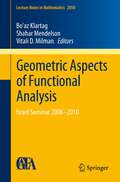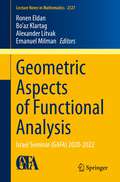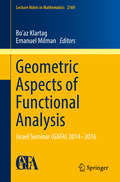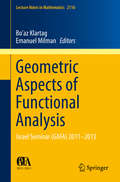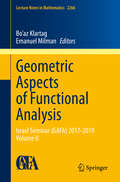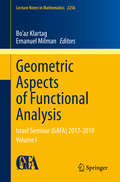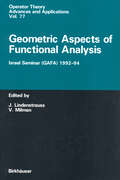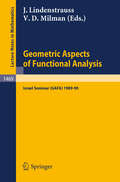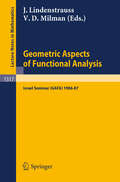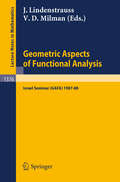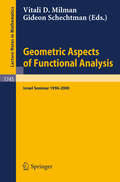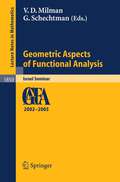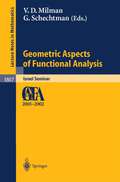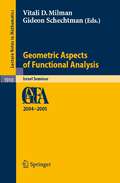- Table View
- List View
Geometric and Topological Mesh Feature Extraction for 3D Shape Analysis
by Jean-Luc Mari Franck Hétroy-Wheeler Gérard SubsolThree-dimensional surface meshes are the most common discrete representation of the exterior of a virtual shape. Extracting relevant geometric or topological features from them can simplify the way objects are looked at, help with their recognition, and facilitate description and categorization according to specific criteria. This book adopts the point of view of discrete mathematics, the aim of which is to propose discrete counterparts to concepts mathematically defined in continuous terms. It explains how standard geometric and topological notions of surfaces can be calculated and computed on a 3D surface mesh, as well as their use for shape analysis. Several applications are also detailed, demonstrating that each of them requires specific adjustments to fit with generic approaches. The book is intended not only for students, researchers and engineers in computer science and shape analysis, but also numerical geologists, anthropologists, biologists and other scientists looking for practical solutions to their shape analysis, understanding or recognition problems.
Geometric Applications of Homotopy Theory I: Proceedings, Evanston, March 21 - 26, 1977 (Lecture Notes in Mathematics #657)
by M. G. Barratt M. E. MahowaldGeometric Applications of Homotopy Theory II: Proceedings, Evanston, March 21 - 26, 1977 (Lecture Notes in Mathematics #658)
by M. G. Barratt M. E. MahowaldA Geometric Approach to Differential Forms
by David BachmanThis text presents differential forms from a geometric perspective accessible at the undergraduate level. It begins with basic concepts such as partial differentiation and multiple integration and gently develops the entire machinery of differential forms. The subject is approached with the idea that complex concepts can be built up by analogy from simpler cases, which, being inherently geometric, often can be best understood visually. Each new concept is presented with a natural picture that students can easily grasp. Algebraic properties then follow. The book contains excellent motivation, numerous illustrations and solutions to selected problems.
A Geometric Approach to Differential Forms
by David BachmanThis text presents differential forms from a geometric perspective accessible at the undergraduate level. It begins with basic concepts such as partial differentiation and multiple integration and gently develops the entire machinery of differential forms. The subject is approached with the idea that complex concepts can be built up by analogy from simpler cases, which, being inherently geometric, often can be best understood visually. Each new concept is presented with a natural picture that students can easily grasp. Algebraic properties then follow. The book contains excellent motivation, numerous illustrations and solutions to selected problems.
A Geometric Approach to the Unification of Symbolic Structures and Neural Networks (Studies in Computational Intelligence #910)
by Tiansi DongThe unification of symbolist and connectionist models is a major trend in AI. The key is to keep the symbolic semantics unchanged. Unfortunately, present embedding approaches cannot. The approach in this book makes the unification possible. It is indeed a new and promising approach in AI. -Bo Zhang, Director of AI Institute, TsinghuaIt is indeed wonderful to see the reviving of the important theme Nural Symbolic Model. Given the popularity and prevalence of deep learning, symbolic processing is often neglected or downplayed. This book confronts this old issue head on, with a historical look, incorporating recent advances and new perspectives, thus leading to promising new methods and approaches. -Ron Sun (RPI), on Governing Board of Cognitive Science SocietyBoth for language and humor, approaches like those described in this book are the way to snickerdoodle wombats. -Christian F. Hempelmann (Texas A&M-Commerce) on Executive Board of International Society for Humor Studies
A Geometric Approach to Thermomechanics of Dissipating Continua (Progress in Mathematical Physics #31)
by Lalao RakotomananaAcross the centuries, the development and growth of mathematical concepts have been strongly stimulated by the needs of mechanics. Vector algebra was developed to describe the equilibrium of force systems and originated from Stevin's experiments (1548-1620). Vector analysis was then introduced to study velocity fields and force fields. Classical dynamics required the differential calculus developed by Newton (1687). Nevertheless, the concept of particle acceleration was the starting point for introducing a structured spacetime. Instantaneous velocity involved the set of particle positions in space. Vector algebra theory was not sufficient to compare the different velocities of a particle in the course of time. There was a need to (parallel) transport these velocities at a single point before any vector algebraic operation. The appropriate mathematical structure for this transport was the connection. I The Euclidean connection derived from the metric tensor of the referential body was the only connection used in mechanics for over two centuries. Then, major steps in the evolution of spacetime concepts were made by Einstein in 1905 (special relativity) and 1915 (general relativity) by using Riemannian connection. Slightly later, nonrelativistic spacetime which includes the main features of general relativity I It took about one and a half centuries for connection theory to be accepted as an independent theory in mathematics. Major steps for the connection concept are attributed to a series of findings: Riemann 1854, Christoffel 1869, Ricci 1888, Levi-Civita 1917, WeyJ 1918, Cartan 1923, Eshermann 1950.
Geometric Approaches to Quantum Field Theory (Springer Theses)
by Kieran FinnThe ancient Greeks believed that everything in the Universe should be describable in terms of geometry. This thesis takes several steps towards realising this goal by introducing geometric descriptions of systems such as quantum gravity, fermionic particles and the origins of the Universe itself. The author extends the applicability of previous work by Vilkovisky, DeWitt and others to include theories with spin ½ and spin 2 degrees of freedom. In addition, he introduces a geometric description of the potential term in a quantum field theory through a process known as the Eisenhart lift. Finally, the methods are applied to the theory of inflation, where they show how geometry can help answer a long-standing question about the initial conditions of the Universe. This publication is aimed at graduate and advanced undergraduate students and provides a pedagogical introduction to the exciting topic of field space covariance and the complete geometrization of quantum field theory.
Geometric Approximation Theory (Springer Monographs in Mathematics)
by Alexey R. Alimov Igor’ G. Tsar’kovThis monograph provides a comprehensive introduction to the classical geometric approximation theory, emphasizing important themes related to the theory including uniqueness, stability, and existence of elements of best approximation. It presents a number of fundamental results for both these and related problems, many of which appear for the first time in monograph form. The text also discusses the interrelations between main objects of geometric approximation theory, formulating a number of auxiliary problems for demonstration. Central ideas include the problems of existence and uniqueness of elements of best approximations as well as properties of sets including subspaces of polynomials and splines, classes of rational functions, and abstract subsets of normed linear spaces. The book begins with a brief introduction to geometric approximation theory, progressing through fundamental classical ideas and results as a basis for various approximation sets, suns, and Chebyshev systems. It concludes with a review of approximation by abstract sets and related problems, presenting novel results throughout the section. This text is suitable for both theoretical and applied viewpoints and especially researchers interested in advanced aspects of the field.
Geometric Aspects of Analysis and Mechanics: In Honor of the 65th Birthday of Hans Duistermaat (Progress in Mathematics #292)
by Erik P. Van Den Ban Johan A. C. KolkHans Duistermaat, an influential geometer-analyst, made substantial contributions to the theory of ordinary and partial differential equations, symplectic, differential, and algebraic geometry, minimal surfaces, semisimple Lie groups, mechanics, mathematical physics, and related fields. Written in his honor, the invited and refereed articles in this volume contain important new results as well as surveys in some of these areas, clearly demonstrating the impact of Duistermaat's research and, in addition, exhibiting interrelationships among many of the topics.
Geometric Aspects of Convex Sets with the Radon-Nikodym Property (Lecture Notes in Mathematics #993)
by R. D. BourginGeometric Aspects of Functional Analysis: Israel Seminar 2006–2010 (Lecture Notes in Mathematics #2050)
by Bo’az Klartag, Shahar Mendelson and Vitali D. MilmanThis collection of original papers related to the Israeli GAFA seminar (on Geometric Aspects of Functional Analysis) from the years 2006 to 2011 continues the long tradition of the previous volumes, which reflect the general trends of Asymptotic Geometric Analysis, understood in a broad sense, and are a source of inspiration for new research. Most of the papers deal with various aspects of the theory, including classical topics in the geometry of convex bodies, inequalities involving volumes of such bodies or more generally, logarithmically-concave measures, valuation theory, probabilistic and isoperimetric problems in the combinatorial setting, volume distribution on high-dimensional spaces and characterization of classical constructions in Geometry and Analysis (like the Legendre and Fourier transforms, derivation and others). All the papers here are original research papers.
Geometric Aspects of Functional Analysis: Israel Seminar (GAFA) 2020-2022 (Lecture Notes in Mathematics #2327)
by Ronen Eldan Bo’az Klartag Alexander Litvak Emanuel MilmanThis book reflects general trends in the study of geometric aspects of functional analysis, understood in a broad sense. A classical theme in the local theory of Banach spaces is the study of probability measures in high dimension and the concentration of measure phenomenon. Here this phenomenon is approached from different angles, including through analysis on the Hamming cube, and via quantitative estimates in the Central Limit Theorem under thin-shell and related assumptions. Classical convexity theory plays a central role in this volume, as well as the study of geometric inequalities. These inequalities, which are somewhat in spirit of the Brunn-Minkowski inequality, in turn shed light on convexity and on the geometry of Euclidean space. Probability measures with convexity or curvature properties, such as log-concave distributions, occupy an equally central role and arise in the study of Gaussian measures and non-trivial properties of the heat flow in Euclidean spaces. Also discussed are interactions of this circle of ideas with linear programming and sampling algorithms, including the solution of a question in online learning algorithms using a classical convexity construction from the 19th century.
Geometric Aspects of Functional Analysis: Israel Seminar (GAFA) 2014–2016 (Lecture Notes in Mathematics #2169)
by Bo'Az Klartag Emanuel MilmanAs in the previous Seminar Notes, the current volume reflects general trends in the study of Geometric Aspects of Functional Analysis, understood in a broad sense. A classical theme in the Local Theory of Banach Spaces which is well represented in this volume is the identification of lower-dimensional structures in high-dimensional objects. More recent applications of high-dimensionality are manifested by contributions in Random Matrix Theory, Concentration of Measure and Empirical Processes. Naturally, the Gaussian measure plays a central role in many of these topics, and is also studied in this volume; in particular, the recent breakthrough proof of the Gaussian Correlation Conjecture is revisited. The interplay of the theory with Harmonic and Spectral Analysis is also well apparent in several contributions. The classical relation to both the primal and dual Brunn-Minkowski theories is also well represented, and related algebraic structures pertaining to valuations and valent functions are discussed. All contributions are original research papers and were subject to the usual refereeing standards.
Geometric Aspects of Functional Analysis: Israel Seminar (GAFA) 2011-2013 (Lecture Notes in Mathematics #2116)
by Bo’az Klartag Emanuel MilmanAs in the previous Seminar Notes, the current volume reflects general trends in the study of Geometric Aspects of Functional Analysis. Most of the papers deal with different aspects of Asymptotic Geometric Analysis, understood in a broad sense; many continue the study of geometric and volumetric properties of convex bodies and log-concave measures in high-dimensions and in particular the mean-norm, mean-width, metric entropy, spectral-gap, thin-shell and slicing parameters, with applications to Dvoretzky and Central-Limit-type results. The study of spectral properties of various systems, matrices, operators and potentials is another central theme in this volume. As expected, probabilistic tools play a significant role and probabilistic questions regarding Gaussian noise stability, the Gaussian Free Field and First Passage Percolation are also addressed. The historical connection to the field of Classical Convexity is also well represented with new properties and applications of mixed-volumes. The interplay between the real convex and complex pluri-subharmonic settings continues to manifest itself in several additional articles. All contributions are original research papers and were subject to the usual refereeing standards.
Geometric Aspects of Functional Analysis: Israel Seminar (GAFA) 2017-2019 Volume II (Lecture Notes in Mathematics #2266)
by Bo’az Klartag Emanuel MilmanContinuing the theme of the previous volumes, these seminar notes reflect general trends in the study of Geometric Aspects of Functional Analysis, understood in a broad sense. Two classical topics represented are the Concentration of Measure Phenomenon in the Local Theory of Banach Spaces, which has recently had triumphs in Random Matrix Theory, and the Central Limit Theorem, one of the earliest examples of regularity and order in high dimensions. Central to the text is the study of the Poincaré and log-Sobolev functional inequalities, their reverses, and other inequalities, in which a crucial role is often played by convexity assumptions such as Log-Concavity. The concept and properties of Entropy form an important subject, with Bourgain's slicing problem and its variants drawing much attention. Constructions related to Convexity Theory are proposed and revisited, as well as inequalities that go beyond the Brunn–Minkowski theory. One of the major current research directions addressed is the identification of lower-dimensional structures with remarkable properties in rather arbitrary high-dimensional objects. In addition to functional analytic results, connections to Computer Science and to Differential Geometry are also discussed.
Geometric Aspects of Functional Analysis: Israel Seminar (GAFA) 2017-2019 Volume I (Lecture Notes in Mathematics #2256)
by Bo’az Klartag Emanuel MilmanContinuing the theme of the previous volumes, these seminar notes reflect general trends in the study of Geometric Aspects of Functional Analysis, understood in a broad sense. Two classical topics represented are the Concentration of Measure Phenomenon in the Local Theory of Banach Spaces, which has recently had triumphs in Random Matrix Theory, and the Central Limit Theorem, one of the earliest examples of regularity and order in high dimensions. Central to the text is the study of the Poincaré and log-Sobolev functional inequalities, their reverses, and other inequalities, in which a crucial role is often played by convexity assumptions such as Log-Concavity. The concept and properties of Entropy form an important subject, with Bourgain's slicing problem and its variants drawing much attention. Constructions related to Convexity Theory are proposed and revisited, as well as inequalities that go beyond the Brunn–Minkowski theory. One of the major current research directions addressed is the identification of lower-dimensional structures with remarkable properties in rather arbitrary high-dimensional objects. In addition to functional analytic results, connections to Computer Science and to Differential Geometry are also discussed.
Geometric Aspects of Functional Analysis: Israel Seminar (GAFA) 1992–94 (Operator Theory: Advances and Applications #77)
by Joram Lindenstrauss Vitali MilmanThis is the sixth published volume of the Israel Seminar on Geometric Aspects of Functional Analysis. The previous volumes are 1983-84 published privately by Tel Aviv University 1985-86 Springer Lecture Notes, Vol. 1267 1986-87 Springer Lecture Notes, Vol. 1317 1987-88 Springer Lecture Notes, Vol. 1376 1989-90 Springer Lecture Notes, Vol. 1469 As in the previous vC!lumes the central subject of -this volume is Banach space theory in its various aspects. In view of the spectacular development in infinite-dimensional Banach space theory in recent years (like the solution of the hyperplane problem, the unconditional basic sequence problem and the distortion problem in Hilbert space) it is quite natural that the present volume contains substantially more contributions in this direction than the previous volumes. This volume also contains many important contributions in the "traditional directions" of this seminar such as probabilistic methods in functional analysis, non-linear theory, harmonic analysis and especially the local theory of Banach spaces and its connection to classical convexity theory in IRn. The papers in this volume are original research papers and include an invited survey by Alexander Olevskii of Kolmogorov's work on Fourier analysis (which was presented at a special meeting on the occasion of the 90th birthday of A. N. Kol mogorov). We are very grateful to Mrs. M. Hercberg for her generous help in many directions, which made the publication of this volume possible. Joram Lindenstrauss, Vitali Milman 1992-1994 Operator Theory: Advances and Applications, Vol.
Geometric Aspects of Functional Analysis: Israel Seminar (GAFA) 1989-90 (Lecture Notes in Mathematics #1469)
by Joram Lindenstrauss Vitali D. MilmanThe scope of the Israel seminar in geometric aspects of functional analysis during the academic year 89/90 was particularly wide covering topics as diverse as: Dynamical systems, Quantum chaos, Convex sets in Rn, Harmonic analysis and Banach space theory. The large majority of the papers are original research papers.
Geometric Aspects of Functional Analysis: Israel Seminar (GAFA) 1986-87 (Lecture Notes in Mathematics #1317)
by Joram Lindenstrauss Vitali D. MilmanThis is the third published volume of the proceedings of the Israel Seminar on Geometric Aspects of Functional Analysis. The large majority of the papers in this volume are original research papers. There was last year a strong emphasis on classical finite-dimensional convexity theory and its connection with Banach space theory. In recent years, it has become evident that the notions and results of the local theory of Banach spaces are useful in solving classical questions in convexity theory. The present volume contributes to clarifying this point. In addition this volume contains basic contributions to ergodic theory, invariant subspace theory and qualitative differential geometry.
Geometric Aspects of Functional Analysis: Israel Seminar (GAFA) 1987-88 (Lecture Notes in Mathematics #1376)
by Joram Lindenstrauss Vitali D. MilmanGeometric Aspects of Functional Analysis: Israel Seminar 1996-2000 (Lecture Notes in Mathematics #1745)
by V. D. Milman G. SchechtmanThis volume of original research papers from the Israeli GAFA seminar during the years 1996-2000 not only reports on more traditional directions of Geometric Functional Analysis, but also reflects on some of the recent new trends in Banach Space Theory and related topics. These include the tighter connection with convexity and the resulting added emphasis on convex bodies that are not necessarily centrally symmetric, and the treatment of bodies which have only very weak convex-like structure. Another topic represented here is the use of new probabilistic tools; in particular transportation of measure methods and new inequalities emerging from Poincaré-like inequalities.
Geometric Aspects of Functional Analysis: Israel Seminar 2002-2003 (Lecture Notes in Mathematics #1850)
by Vitali D. Milman Gideon SchechtmanThe Israeli GAFA seminar (on Geometric Aspect of Functional Analysis) during the years 2002-2003 follows the long tradition of the previous volumes. It reflects the general trends of the theory. Most of the papers deal with different aspects of the Asymptotic Geometric Analysis. In addition the volume contains papers on related aspects of Probability, classical Convexity and also Partial Differential Equations and Banach Algebras. There are also two expository papers on topics which proved to be very much related to the main topic of the seminar. One is Statistical Learning Theory and the other is Models of Statistical Physics. All the papers of this collection are original research papers.
Geometric Aspects of Functional Analysis: Israel Seminar 2001-2002 (Lecture Notes in Mathematics #1807)
by Vitali D. Milman Gideon SchechtmanThe proceedings of the Israeli GAFA seminar on Geometric Aspect of Functional Analysis during the years 2001-2002 follow the long tradition of the previous volumes. They continue to reflect the general trends of the Theory. Several papers deal with the slicing problem and its relatives. Some deal with the concentration phenomenon and related topics. In many of the papers there is a deep interplay between Probability and Convexity. The volume contains also a profound study on approximating convex sets by randomly chosen polytopes and its relation to floating bodies, an important subject in Classical Convexity Theory. All the papers of this collection are original research papers.
Geometric Aspects of Functional Analysis: Israel Seminar 2004-2005 (Lecture Notes in Mathematics #1910)
by Vitali D. Milman Gideon SchechtmanThis collection of original papers related to the Israeli GAFA seminar (on Geometric Aspects of Functional Analysis) during the years 2004-2005 reflects the general trends of the theory and are a source of inspiration for research. Most of the papers deal with different aspects of the Asymptotic Geometric Analysis, ranging from classical topics in the geometry of convex bodies to the study of sections or projections of convex bodies.
